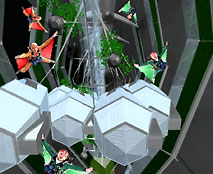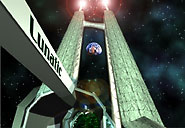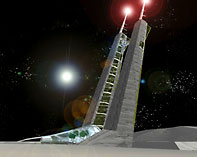- tourism
- Hotel on the Moon
|
Hans-Jurgen Rombaut |
 |
As I have no data on a lot of financial issues involved such as the costs of transporting materials to the moon, mining ores and producing building materials on the moon, I can not even give you a rough estimate of the cost for this building. However transportation clearly is the biggest expense. Therefor I tried to use as much materials that can be manufactured on the moon.
Due to the lack of atmosphere and climate the building will not erode. (The footprints of the ?apollo? astronauts are exactly as they were left there more than 30 years ago, as there is no wind or rain the erode them). The only damage may be caused by small meteorites hitting the outer hull of the construction. Replacing a part of the plating once in a while might be necessary. The construction of the outer hull is a double lunar rock plating (check my website for technical drawing http://www.rombaut.nl).
The sleepingspaces
 |
Each capsule will have its own supply of freshwater and a rubbish and sewage disposal unit that will be changed every day by thehotel staff.
Visitors will be encouraged to walk to the restaurants (earth-orbit-designed to look at the earth with the naked eye and with telescopes, see my website: http://www.rombaut.nl, and solar-orbit lounge designed for viewing at the galaxy with telescopes) at the top of the towers instead of using elevators, helping avoid muscle deterioration during their two-week stay.
 |
Cosmic rays
The low gravity - one-sixth of the Earth?s - and the absence of wind were a boon for me: I was able to design a much more slender and fragile-looking building than would have been possible on Earth.
But keeping the harsh lunar environment out was quite another matter. Temperatures vary between 100 ?C and ?150 ?C, and lethal cosmic rays and solar particles bombard the lunar surface, unimpeded by the ultra-thin atmosphere.To shield the interior from this onslaught, I designed a 50-centimetre-thick hull. It consists of two outer layers of Moon rock and a 35-centimetre layer of water held between glass panes. The water absorbs energetic particles and helps keep the temperature constant, and the Moon rock provides further protection.
Windows are formed simply from holes in the Moon-rock
layer. Thanks to the low
gravity, the hull will weigh less than a seven-centimetre-thick layer of
concrete on Earth.
The cost of launching tonnes of steel and water to the Moon is clearly a hurdle. As much as possible has to be manufactured on the Moon itself, using existing minerals and ores,. It is possible that there are large amounts of water on the Moon, stored as ice in craters near the south pole that stay permanently in shadow.
I think It would cost around 120,000 us$ for a trip and of course it all in. But trying to say how much it is within 50 years is still difficult. I hope (and think) that humankind will invent a cheaper way to go into space.
Visit me at:
http://www.rombaut.nl
[September 2001.]

